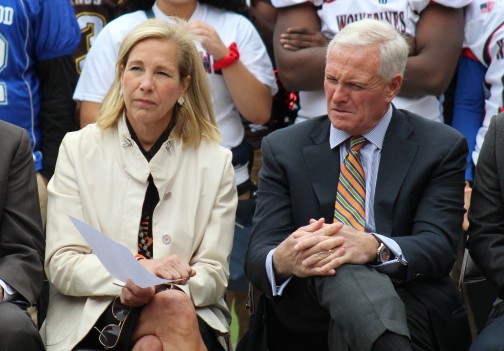If you were buying an NFL franchise like the Browns, why would you leave the seller 30% of the team for four years?
The simple answer: because $1 billion is too big a check for you to write all at once. You need that time to come up with the remaining $300 million.
And that’s how the Haslam group’s purchase from the Lerners is structured. That final check is due a few weeks from now, in October.
Since that 2012 deal closed, the source and engine of the Haslam fortune has been hit with huge unanticipated liabilities of its own doing. You’ve heard of the Pilot/Flying J rebate fraud scandal? Well, by now Jimmy Haslam III has certainly heard way too much about it.
The company has paid a $92 million civil penalty to the feds and another $85 million to settle a class action suit. Still pending are cases from victims who opted out of the class action. There are multimillions in continuing legal fees. So far ten people have pleaded guilty to charges related to fraud, and eight more ex-employees (including PFJ’s former president) are scheduled for federal criminal trial next year. Jimmy Haslam himself has been neither charged nor cleared.
So what does this have to do with football?
For one thing, it’s easy to see that Haslam intended to turn his attention to the Browns, but then got pulled back into the mess at the family business after the 2013 FBI raid of its Knoxville headquarters. He hired a successor CEO only to return a few months later to his “first love.”
If I had more time, I could try to dig up financial details on all the executives and coaches Haslam has dispensed with one way or another. Mike Holmgren, Tom Heckert, Fred Nance, Pat Shurmur, Rob Chudzinski, Joe Banner, Mike Lombardi, Jon Sandusky, Ray Farmer, Morocco Brown, Bill Kuharich, Mike Pettine, Alec Sheiner. Dozens of assistant coaches and coordinators. While not everyone gets severance or had a guaranteed contract with years remaining, that’s still a whole lot of money to pay to make people go away.
To try to settle things down, Dee Haslam has taken a more active role in recent months, and her increased presence is among the most welcome aspects of the entire four-year reign of error.
The newest hired brass seem committed to an extreme value-driven youth movement that just so happens to require the least possible near-term cash outlay. Whether this strong frugality is a direct mandate of ownership or merely a convenient coincidence with what appears to be its most immediate need — preserving cash to safely make that $300 million payment — is a question for some skilled, investigative Browns journalist to illuminate. Hypothetically, of course.
Let’s set some circumstantial fiscal facts on the table.
- When he fired Chud immediately after the 2013 season, Haslam went out of his way to mention the financial expense of doing so as a measure of his commitment to “get this right.” So he has been acting since at least that time with a degree of cost-consciousness (if not prudence).
- In the very next draft, the Browns traded down from the fourth-overall pick (passing on Sammy Watkins and Khalil Mack) and made their first selection at number eight, where Justin Gilbert‘s rookie contract was $7.1 million cheaper than Watkins’.
- The 2014 Browns had the second-most unspent cap space of any team, over $21 million. They rolled over a similar amount the next year as well.
- The following homegrown starters have left for other teams in free agency after Cleveland proved unwilling or unable to re-sign them: Jabaal Sheard, T.J. Ward, Buster Skrine, Alex Mack, Mitchell Schwartz, Travis Benjamin, Tashaun Gipson, Ahtyba Rubin, Jordan Cameron, and Craig Robertson.
- The Browns again traded out of a high first-round pick this year, moving from second overall to 15th. Their biggest free agent contract by far was with Robert Griffin III, signed for two years for between $6.75 and $22 million, depending on incentives, making him one of the cheaper starting quarterbacks in the league.
- No matter which source you use, the Browns are in line to spend the very least of any team on its active players this year. Despite having the second-highest dead cap figure, they have more unspent room under the salary cap than any other team.
- That’s partly because so many of their first-rounders have busted. It’s partly because they’ve cut or traded much more than a handful of veteran contributors in recent months. And it’s partly because they’ve made the decision to zip the wallets closed, hold off on re-signing players nearing the ends of their contracts, and amass future draft picks.
Long-suffering Browns fans must be forgiven if they aren’t in the mood for continued patience. This ain’t the expansion era. They’re not starting from ground zero. They’re crawling out from the epic crater beneath it.
Even if this Moneyball philosophy is successfully applied in the long run, even if they maneuver shrewdly and unearth undervalued gems, even if Hue ekes out a credible semblance of an NFL team from this raw roster, and even if the Haslams fork over that final check with no sweat, the truth behind it all seems inescapable.
The Browns haven’t just been inept or chronically mismanaged, though both are true. They are actively skimping on talent.
And so their fans, indirectly, can be added to the long list of fraud victims.
